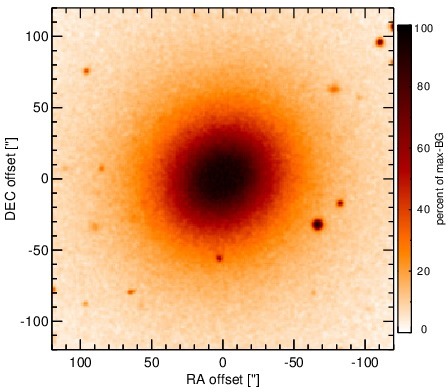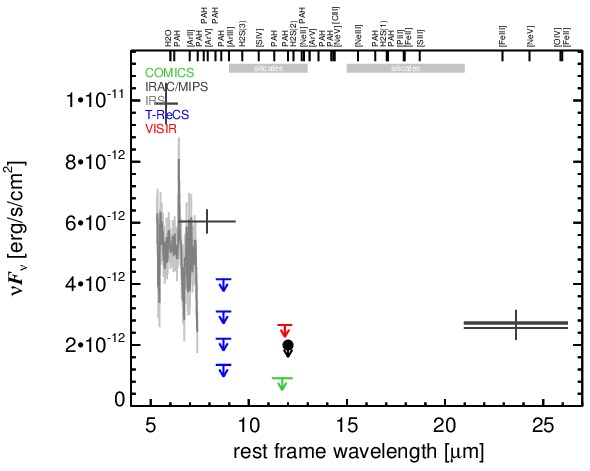Sasmirala Individual Information for NGC 4374
Description
NGC 4374 is a dusty giant elliptical in the Virgo cluster at a distance of D = 17.1 ± 2.4 Mpc (NED redshift-independent median) with FR I radio morphology and an radio-loud AGN classified either as LINER [ho_search_1997-1] or Sy 2 [veron-cetty_catalogue_2010]. Two parallel dust lanes are seen perpendicular to the radio jet axis with one crossing the nucleus (PA~ 60∘; [hansen_properties_1985, jaffe_hubble_1994, bower_nuclear_1997]). The first N-band photometry of NGC 4374 was obtained with IRTF in 1983 [impey_infrared_1986] where the nucleus was weakly detected at 21 mJy (5.7arcsecaperture). After IRAS, NGC 4374 was also observed with ISO/ISOCAM where it appeared extended and diffuse [ferrari_survey_2002, siebenmorgen_isocam_2004, xilouris_dust_2004]. This is also the case in the IRAC 5.8 and 8.0 μm: the nucleus appears as an extended emission peak without any clearly separable unresolved component. Only in the MIPS 24 μm image, an unresolved component embedded in diffuse emission is dominating. We measured the nuclear component in the IRAC 5.8 and 8.0 μm and MIPS 24 μm images, which yields much lower values than the total fluxes published in the literature [tang_infrared-red_2009, temi_spitzer_2009]. For extended objects such as NGC 4374, the PBCD IRS LR mapping mode spectrum is not very reliable but matches qualitatively the more accurate version by [leipski_spitzer_2009]. While the latter authors presented a complete MIR spectrum we could only retrieve the shortest wavelength setting from the Spitzer archive. The MIR SED from [leipski_spitzer_2009] exhibits a weak silicate 10 μm absorption feature and prominent PAH 11.3 μm emission, i.e., star formation might be present. The nucleus of NGC 4374 was observed with T-ReCS in the Si2 filter in 2008 during four nights (two of which are published in [mason_nuclear_2012]). In addition, we observed it with COMICS in the N11.7 filter in 2009, and others performed VISIR PAH2_2 imaging in 2010 (both unpublished, to our knowledge). In all these subarcsecond-resolution N-band images, the object remained undetected. Together with the derived upper limit, which are significantly lower than the Spitzer data, this indicates that the MIR emission of NGC 4374 is totally host-dominated even at arcsecond scales.
- [bower_nuclear_1997] Gary A. Bower, Timothy M. Heckman, Andrew S. Wilson, and Douglas O. Richstone. The nuclear ionized gas in the radio galaxy m84 (NGC 4374) . ApJL , 483 pp. L33, July 1997.
- [ferrari_survey_2002] F. Ferrari, M. G. Pastoriza, F. D. Macchetto, C. Bonatto, N. Panagia, and W. B. Sparks. Survey of the ISM in early-type galaxies. IV. the hot dust component . A&A , 389 pp. 355–366, July 2002.
- [hansen_properties_1985] L. Hansen, H. U. Norgaard-Nielsen, and H. E. Jorgensen. Properties of the dust lane and ionized gas in m84 . A&A , 149 pp. 442–448, August 1985.
- [ho_search_1997-1] Luis C. Ho, Alexei V. Filippenko, and Wallace L. W. Sargent. A search for ``Dwarf'' seyfert nuclei. III. spectroscopic parameters and properties of the host galaxies . ApJS , 112 pp. 315, October 1997.
- [impey_infrared_1986] C. D. Impey, C. G. Wynn-Williams, and E. E. Becklin. Infrared studies of elliptical galaxies. i - an optically selected sample . ApJ , 309 pp. 572–592, October 1986.
- [jaffe_hubble_1994] W. Jaffe, H. C. Ford, R. W. O'Connell, F. C. van den Bosch, and L. Ferrarese. Hubble space telescope photometry of the central regions of virgo cluster elliptical galaxies. 1: Observations, discussion, and conclusions . AJ , 108 pp. 1567–1578, November 1994.
- [leipski_spitzer_2009] C. Leipski, R. Antonucci, P. Ogle, and D. Whysong. The spitzer view of FR i radio galaxies: On the origin of the nuclear mid-infrared continuum . ApJ , 701 pp. 891–914, August 2009.
- [mason_nuclear_2012] R. E. Mason, E. Lopez-Rodriguez, C. Packham, A. Alonso-Herrero, N. A. Levenson, J. Radomski, C. Ramos Almeida, L. Colina, M. Elitzur, I. Aretxaga, P. F. Roche, and N. Oi. The nuclear infrared emission of low-luminosity active galactic nuclei. AJ , 144 pp. 11, July 2012.
- [siebenmorgen_isocam_2004] R. Siebenmorgen, W. Freudling, E. Krügel, and M. Haas. ISOCAM survey and dust models of 3CR radio galaxies and quasars . A&A , 421 pp. 129–145, July 2004.
- [tang_infrared-red_2009] Yuping Tang, Q.-S. Gu, J.-S. Huang, and Y.-P. Wang. Infrared-red cores in nearby elliptical galaxies . MNRAS , 397 pp. 1966–1975, August 2009.
- [temi_spitzer_2009] Pasquale Temi, Fabrizio Brighenti, and William G. Mathews. Spitzer observations of passive and star-forming early-type galaxies: An infrared color-color sequence . ApJ , 707 pp. 890–902, December 2009.
- [veron-cetty_catalogue_2010] M.-P. Véron-Cetty and P. Véron. A catalogue of quasars and active nuclei: 13th edition . A&A , 518 pp. 10, July 2010.
- [xilouris_dust_2004] E. M. Xilouris, S. C. Madden, F. Galliano, L. Vigroux, and M. Sauvage. Dust emission in early-type galaxies: The mid-infrared view . A&A , 416 pp. 41–55, March 2004.
Images

Optical image (DSS, red filter). Displayed are the central 4 arcmin with North being up and East to the left. The colour scaling is linear with white corresponding to the median background (BG) and black to the 0.01% pixels with the highest intensity.

Spitzer MIR images. Displayed are the inner 40 arcsec with North being up and East to the left. The colour scaling is logarithmic with white corresponding to median BG and black to the 0.1% pixels with the highest intensity. The label in the bottom left states instrument and central wavelength of the filter in micron (I: IRAC, M: MIPS).
SEDs


MIR SED. The description of the symbols in all the SED plots (where present) is the following: Grey crosses and solid lines mark the Spitzer/IRAC, MIPS and IRS data. The colour coding of the other symbols is as follows: green for COMICS, magenta for Michelle, blue for T-ReCS and red for VISIR data. Darker-coloured solid lines mark spectra of the corresponding instrument. The black filled circles mark the nuclear 12 and 18 micron continuum emission estimate from the data (where present). The ticks on the top axis mark positions of common MIR emission lines, while the light grey horizontal bars mark wavelength ranges affected by the silicate 10 and 18 micron features.